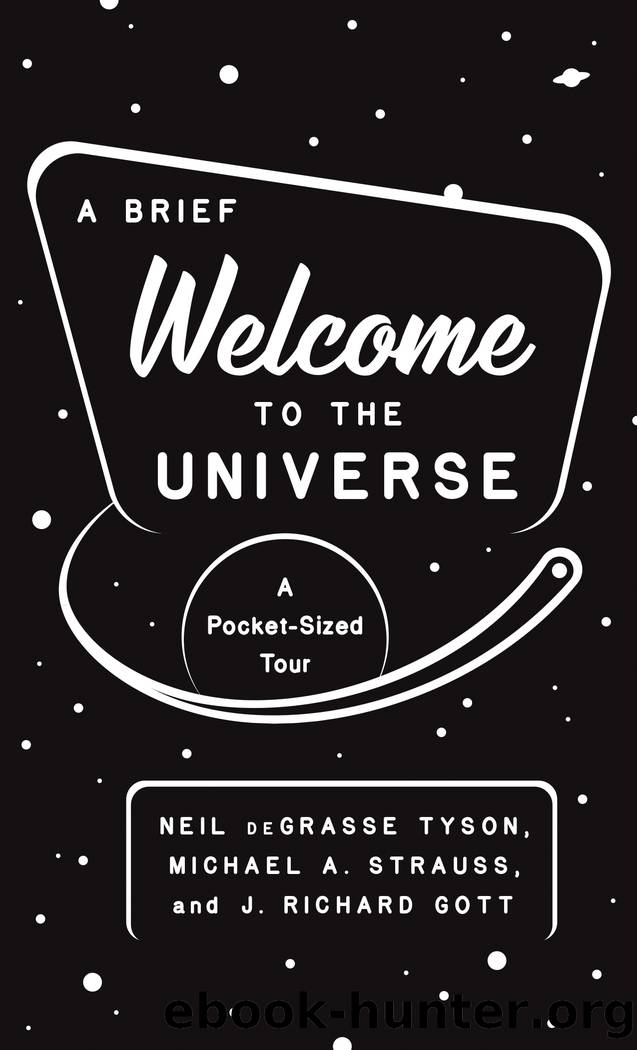A Brief Welcome to the Universe by Neil deGrasse Tyson

Author:Neil deGrasse Tyson [Tyson, Neil deGrasse]
Language: eng
Format: epub
Publisher: Princeton University Press
Published: 2021-07-27T00:00:00+00:00
Each of the more than 50,000 dots in this figure represents a galaxy of 100 billion stars.
We can see two big slices of the pie; the Milky Way galaxy sits at the center of the image. The empty regions on the left and the right fall outside the survey region, where dust from the Milky Way makes it difficult to pick out distant galaxies.
The radius of this figure is 860 megaparsecs, almost 3 billion light-years. Even a cluster of galaxies appears small in this picture, but the majority them lie along filaments, hundreds of millions of light-years long. A particularly prominent filament with a length of 1.37 billion light-years, dubbed the Sloan Great Wall, appears somewhat above the center of the image. Measuring this structure got Rich and his colleague Mario JuriÄ into the 2006 Guinness Book of World Records for âlargest structure in the universe.â
Notice in the figure that the density of galaxies drops off near the outer edges of the map. Thatâs because galaxies in these regions are the most distant from us and are therefore the faintest. Only a small fraction of the most distant galaxies are bright enough for the Sloan Digital Sky Survey to measure their redshifts so that they can be included in this map.
Just as with the CMB, we can compare the patterns of structures traced by the galaxies with what weâd expect in an expanding universe subject to gravity. The result? Detailed computer simulations, including the effects of dark matter and dark energy, give rise to structures whose statistical properties beautifully match those seen in the Sloan image.
This, then, is the final triumph of the Big Bang model. We have explored the predictions of the model and compared them with observations in every way that we could. We inferred that the universe was born 13.8 billion years ago, slightly older than the ages of the oldest stars. We concluded that hydrogen and helium nuclei were formed in the first few minutes after the Big Bang, in a 12:1 ratio, which is exactly what we observe. We predicted the existence and the temperature of the CMB. We predicted that the CMB should not be perfectly smooth but should show fluctuations at one part in 100,000, with statistical properties in beautiful accord with observations. Finally, computer models of how these fluctuations should grow under gravitational instability predict a highly structured universe today, with galaxies arrayed along filaments hundreds of millions of light-years long, just as the maps from the Sloan Digital Sky Survey reveal. The Big Bang model is far more than âjust a theory.â Itâs supported by a vast array of empirical, quantitative evidence and has passed every test we have given it with flying colors.
Download
This site does not store any files on its server. We only index and link to content provided by other sites. Please contact the content providers to delete copyright contents if any and email us, we'll remove relevant links or contents immediately.
Turbulence by E. J. Noyes(7033)
Tools of Titans by Timothy Ferriss(6938)
Astrophysics for People in a Hurry by Neil DeGrasse Tyson(4614)
Room 212 by Kate Stewart(4099)
Pale Blue Dot by Carl Sagan(3997)
The David Icke Guide to the Global Conspiracy (and how to end it) by David Icke(3876)
Secrets of Antigravity Propulsion: Tesla, UFOs, and Classified Aerospace Technology by Ph.D. Paul A. Laviolette(3432)
Apollo 8 by Jeffrey Kluger(3196)
Losing the Nobel Prize by Brian Keating(3184)
A Journey Through Divination and Astronomy by Publishing Pottermore(3033)
Goodbye Paradise(2951)
COSMOS by Carl Sagan(2944)
Brief Answers to the Big Questions by Stephen Hawking(2873)
How to Read Water: Clues and Patterns from Puddles to the Sea (Natural Navigation) by Tristan Gooley(2849)
The Five People You Meet in Heaven by Mitch Albom(2835)
The Order of Time by Carlo Rovelli(2708)
How to Read Nature by Tristan Gooley(2657)
A Brief History of Time by Stephen Hawking(2471)
Aliens by Jim Al-Khalili(2376)
